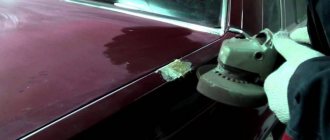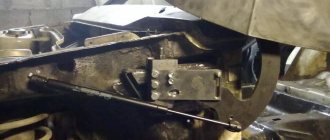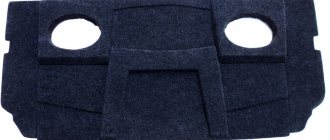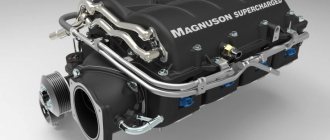Many people who are interested in tuning are interested in how to make coilovers with their own hands, as well as what they are.
After all, this type of tuning appeared relatively recently. In this regard, not everyone knows what this modification is. Moreover, it should be noted that many people who have tried such stands are not going to give them up in the future. Below we will consider all the features of such a modification. The fashion trend was picked up by large manufacturers of tuning parts, but this option is not very popular, the price of the parts is too high. This is precisely what drives motorists’ desire to solve this problem on their own.
What are coilovers? We make a sports suspension - with our own hands
Before we had time to understand such a concept as a downpipe , our folk tuners found a new “wave”, rejoice the “lowering” of our PRIOR - meet coilovers. The trend came, as usual, from the west; it can be matched to almost any car (VAZ is no exception). With their help, you can either raise or lower the suspension extremely, in general, it’s just a saying for tuning - the coolest thing is that today you can ride with one setting, and tomorrow with another. As usual, I’ll tell you in simple words and show you in the video at the end...
THE CONTENT OF THE ARTICLE
Coil over (Coilovers) - the literal translation of “coil - coil and above - over” (that is, a coil up) is a regular car strut (that is, a shock absorber + spring), only with the ability to move the spring in height. Often the coilover body is made in the form of a screw, along which a special coupling (stop) moves; it can either raise the spring or lower it - accordingly, the suspension either rises or lowers.
To put it in simple words, this is a screw housing along which the spring stop runs. It is necessary for precise and fine adjustment of the suspension, often used in sports competitions or, say, during “drifting”.
What it is?
How to make coilovers with your own hands? To answer this question, it is advisable to understand the features of this device. In a nutshell, this is a stand with height adjustment. This is what the screw thread is for. Thanks to this, you do not have to cut the spring struts. The adjustment is made by unscrewing or tightening the coupling on the shock absorber. This allows you to lower the car without reducing the ride quality of the suspension. After all, the spring retains its length, the shock absorber is not clamped, and is able to perform its work completely as usual.
Now let's move on to the question of what this tuning gives, besides a low landing. The thing is that with proper regulation, the camber angle can be slightly corrected. This allows you to achieve higher performance on sports and drift cars.
How are they different from regular racks?
As you understand, a regular strut - a spring and a shock absorber inside, initially - a non-adjustable suspension. That is, the lower stop in the strut rigidly holds the spring, as well as the lower mount (which is attached to the suspension), an absolutely non-adjustable design. All you can do with your own hands to tune such a one-piece suspension is to trim the coils on the spring, which will cause the shock absorber rod to sink down and the car to become lower. This is what hundreds of popular tuners actually do; probably everyone has seen lowered cars .
Coilover device
The base is still a regular shock absorber stock, only with improved characteristics - it should still work in various ranges, from the tightest (compression) to the loosest (increase).
A thread is cut onto its body, or a cover with a screw thread is put on. From below, as in principle on a regular screw, a stop (or a backup coupling) is screwed on; as it becomes clear, it can move up and down the thread.
The spring is installed between the upper stop and the lower (changeable) one.
At the top of such a rack there is a mount, in the usual “socket” of the rack on the body. The lower part of the mount is also put on (screwed onto the thread) and can move up and down.
The device is essentially very simple.
General information about the suspension
To better understand what a coilover is, you must first turn to the most common shock absorber. Its device is shown in the photo below.
Any shock absorber is a cylinder filled with liquid (usually oil) in which a piston moves. The principle of operation of the device is the flow of liquid from one volume to another when the piston moves in one direction or another under the influence of a changing load.
There are different types of shock absorbers, but each one works in a similar way. Thanks to this, vibrations transmitted from the road to the car body are dampened and constant contact of the wheels with the road is ensured.
Types of coilovers
At the moment, there are all two main types:
- Allows you to mount a threaded enclosure onto your stock rack, making it essentially a must-have upgrade kit. The downside of such a system is that the standard rack may not be able to cope with the increased load on it and will quickly fail. Also, if the compression is too strong, it practically stops working altogether, which affects the handling of the car.
additional information
However, adjustable suspension has not only advantages, it also has disadvantages.
- Coilovers require careful maintenance and monitoring. In most cases, there are no seals on the rods to prevent dust and dirt from entering the body. And this leads to rapid wear of the bushings, which will result in knocking and jamming of the rod.
- Such a suspension must be adjusted for certain conditions, for example, driving on gravel or asphalt. If the coilovers are set to one surface, but you have to move differently, then this is fraught with shaking and the possibility of damage to the suspension. So, on asphalt it should work with short strokes, on gravel - with long strokes. If the suspension is not configured correctly, it will not follow the road profile, resulting in poor handling.
- Significant shaking when driving does not indicate that the suspension is working, but that it does not correspond to the driving conditions.
Coilovers allow you to change the characteristics of the existing suspension on your car. However, it must be designed for specific driving conditions and may not work equally well on different surfaces. So the use of such elements in a car must be treated with caution and the consequences of their use must be fully understood.
How much can you lower a car?
I know this question is now on the minds of many readers, rejoice guys:
The average lowering rate is from 20 to 35 mm, very good, now you don’t need to cut off the coils, you can lower your car simply by unscrewing the lower stop. In terms of ground clearance, this can give simply stunning figures. Fluctuations can range from 20 to 100 mm. Although when cutting springs, many achieve a lowering of 30 - 50 mm.
If your car is “pumped” and you need to perform at any shows, such as drifting or other sporting events. In just a couple of hours the car drops to the required ground clearance. After the show, it can be raised to a normal “sane” size and move around the city perfectly.
Lada 2110 1.5 Turbo › Logbook › Why screws/coilovers are a joke.
For many, and not only for die-hard BPAN chicks, a suspension with variable height is a lifelong dream; many buy a coil suspension just to show off, well, it’s kind of cool. Everyone has heard that supposedly lowering the car magically improves handling. Few people understand exactly what disadvantages this brings with the wrong approach. I won’t bore you with theory, I’ll just draw your attention to one thing that SS20 has brought out remarkably well. Don't take this as an advertisement, but I will use their illustrations, so I'm linking to the source.
So, you have a stock suspension. Discarding everything else, let's look at the location of the rack and shock absorber bipods. The bipod is on the same axis with the rack, the mustache rises to the height of the ball joint.
Now we take the variable height suspension. It doesn’t matter what it will be, fashionable coilovers with anodized coating from a famous brand, ordinary screws from a converted stock shock absorber, or even air. An important fact is that the height of the shock absorber bipod (where the rack is attached) is almost always unchanged. Very often it does not differ or does not differ significantly from the factory height. What happens when you underestimate:
The helmsman's mustache goes up. Well, it would seem - and to hell with them, why will this make steering worse? YES, IT WILL BE. You will then go to the breakdown, right? And in this position, you will be set to zero or so when you stand on a perfectly flat workshop floor. Now let's see what happens when you leave the box using the example of one side (one mustache). Let's imagine that you run over a bump on one side, no matter how it is, a smooth hole, a rut, or any unevenness. The shock absorber compresses, the bipod with the steering arm rises, and you keep the steering wheel straight as you were holding it. The following picture illustrates the difference in what will happen to your alignment:
The rack's mustache is located on an axis around which it moves in a circle. If the shock absorber rises, the bipod, which is screwed by the ball to the mustache, rises. Since the circumferential movement is inevitable (the mustache pulls on the bipod), it is obvious that the bipod will move inward and turn the wheel a little
.
In the case of the factory position of the arm, even despite the decent travel of the shock absorber, this rotation is insignificant. In the case when the arm is raised, with the same shock travel, the arm will not only be forced to travel more distance along its diameter, but will also pull the bipod closer to itself , because now its movement is closer to parallel to the ground.
Those in the topic have already understood that I am trying to tell about Bump Steer, or Shock Steering in Russian. This is when, having hit a bump, your wheels suddenly develop a positive divergence, they begin to look in different directions and the face begins to wag. You have to catch the car to stay in the lane. If you have never felt this, imagine that you are driving along a highway at 100 km/h and suddenly the car jumps to the side half a meter, although the steering wheel is standing still. Scary? This will become a regular event.
In general, our view of helical suspension is fundamentally incorrect; spring adjustment is needed not only and not so much to change the height of the car, but to change the spring preload. If the spring has a progressive characteristic, then by tightening it you will delay the load moment at which it begins to compress (roll begins). The height of the car is a consequence. On a normal suspension (popularly Full Tap) with variable spring preload
The shock absorber shoe on which the bipod is located is height adjustable. Thus, by increasing the spring preload, realizing that the car must lower, we can remove the larger shock absorber housing from the shoe, leaving the height of the car the same and maintaining the suspension geometry. Again, don’t take this as advertising, but today I know of only one manufacturer of can hangers that produces such FUCKING screws:
By the way, BMW has an adjustable shoe in stock











